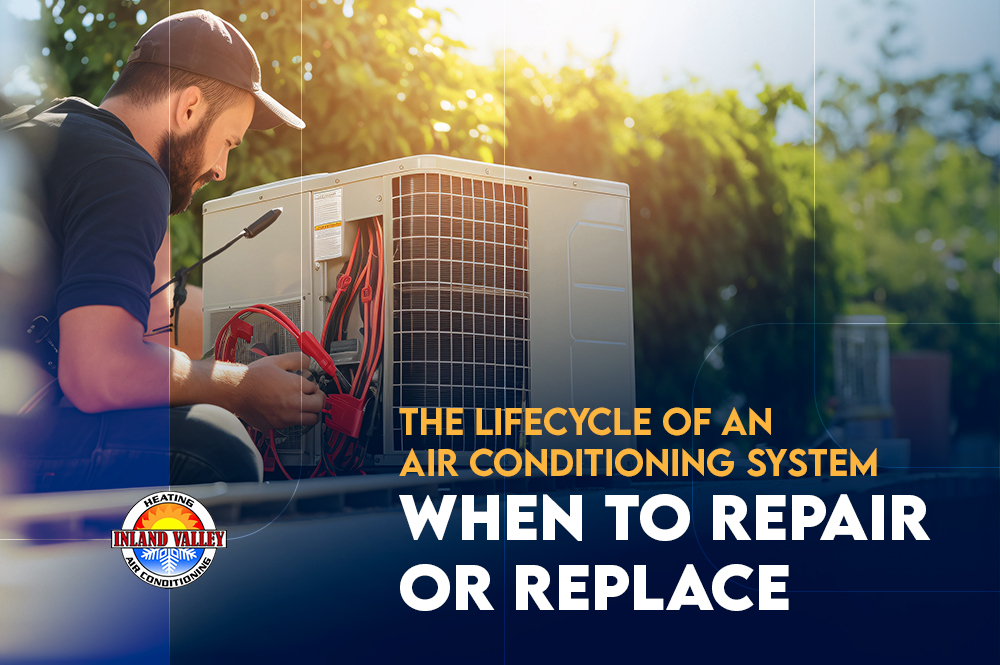Overview: Is your air conditioner on its last leg, or does it just need a little TLC? The lifecycle of an air conditioning system, from installation bliss to the tough decisions of repair or replacement is a journey worthwhile — and we’re here to help! Let’s make your home’s comfort a breeze!
In the sweltering embrace of summer or the unexpected heatwaves of spring and autumn, air conditioning systems stand as our silent guardians against discomfort. Yet, like all guardians, they too have their vulnerabilities and life spans. Understanding the lifecycle of an air conditioning system can save homeowners from the anguish of unexpected breakdowns and the dilemma of whether to repair or replace.
This blog post will take you through the lifecycle of an air conditioning system, highlighting key milestones, maintenance tips, and the pivotal decision points between repair and replacement.
Installation and Early Years
The journey of an air conditioning system begins with its installation, a critical phase that sets the stage for its operational efficacy and longevity. Proper sizing and professional installation are paramount, ensuring that the system operates at peak efficiency and minimizes future repairs.
In its early years, your system should run smoothly with minimal maintenance, such as regular filter changes and annual professional check-ups to ensure everything is functioning as it should.
Peak Performance and Routine Maintenance
As the system ages into its prime, routine maintenance becomes the key to sustaining its peak performance. This period, typically between 3 to 7 years after installation, is when homeowners should adhere to a strict maintenance regimen:
Regular Filter Changes: Depending on the model, filters should be changed every 1 to 3 months to ensure optimal air flow and air quality.
Annual Inspections: Professional inspections can catch minor issues before they escalate into major problems, ensuring your system runs efficiently.
Cleaning Coils and Fans: Ensuring these components are clean can significantly impact the system’s efficiency and life span.
During this phase, repairs may be necessary but are generally minor and infrequent if the system is well-maintained.
Signs of Aging and Considerations for Repair
As the system crosses the decade mark, signs of aging, such as increased energy bills, frequent repairs, and decreased efficiency, become more apparent. Repairs during this stage must be carefully considered. If your system uses R-22 Freon, which is being phased out due to environmental concerns, finding refrigerant for repairs can be both challenging and expensive.
It’s also a good time to evaluate the system’s SEER (Seasonal Energy Efficiency Ratio) rating; upgrading to a higher SEER rating can offer significant energy savings and environmental benefits.
>> Related Reading: What’s a Good SEER Rating in 2024?
The Decision: Repair or Replace?
The decision to repair or replace hinges on several factors:
Age of the System: If your system is over 10 years old and facing significant repairs, replacement may be a more economical and efficient choice.
Cost of Repairs: A good rule of thumb is the 50% rule. If the cost of repairs approaches 50% of the value of your system, replacement is generally recommended.
Energy Efficiency: Modern air conditioning systems are significantly more energy-efficient. Upgrading can reduce your energy bills and carbon footprint.
Incentives: Tax credits, rebates, and manufacturer incentives can offset the cost of a new system, making replacement a financially attractive option.
Replacement and the Beginning of a New Cycle
Choosing to replace your air conditioning system marks the end of its lifecycle and the beginning of a new one. Modern systems offer advancements in technology, energy efficiency, and environmental friendliness, promising not only enhanced comfort but also savings on energy bills and a reduced environmental impact.
Final Thoughts
The lifecycle of an air conditioning system is a journey of vigilance, care, and strategic decision-making. By understanding this lifecycle, homeowners can ensure their system operates efficiently, decide wisely between repair and replacement, and ultimately, enhance their home’s comfort and value.
Whether it’s the dawn of installation, the midday of routine maintenance, or the dusk of aging, each phase offers an opportunity to optimize the performance and longevity of your air conditioning system, ensuring it remains a reliable guardian against the heat.

